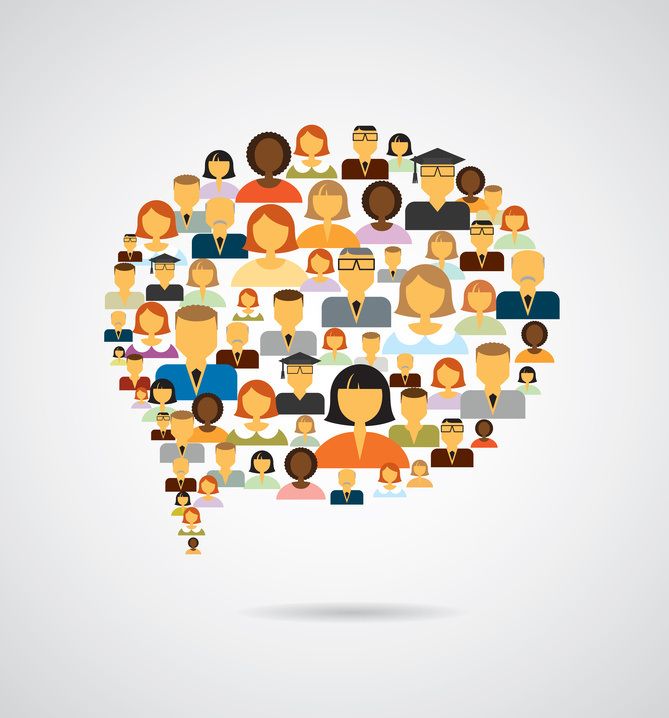First of all we have to distinguish between Interpersonal communication which means the ability of a person to use appropriate communication to establish and maintain an effective relationship and Intrapersonal communication which means communication with oneself not requiring another person only one communicator. So we can say that communication is our link to humanity. But how do people decide to speak with each other face-to-face or send a text? It may depends on the situation or especially on the other people. So every day, we engage in interpersonal communication with family, friends, with people we have just met or we have known all our lives, face-to-face and online, in person and via our phones. Through our personal contacts, we establish relationships and build connections to realize our personal goals and satisfy our social needs. As we relate to others, this has a direct link between how good we are at communicating and how fulfilling we find life. So interpersonal communication is when you interact with another person. Indeed the interpersonal communication has four main characteristics, first one Dynamic process which means ongoing and continuous and in a constant state of flux. Second one Unrepeatable and irreversible that is to say it’s unique, it has never happened that way before and it will never happen in just that way again, we cannot restart communication as we can like a TV program, we cannot unseen sights, unheard words, or undo acts. The third is learned we find out over time what works for us and what doesn’t work if we remain conscious of the communication. And the last one is Characterized by wholeness and non commutativity it operates as a complete entity, much like a team functions.
Intercultural communication: Same language, but different codes
If we do not understand each other, it is because we do not speak the same language. But, is learning a language an effective communication tool for producing and understanding statements from members of the foreign culture? When we think of intercultural communication, we directly think of verbal communication, and when we talk about verbal communication we talk about ‘language’, the latter allows us to penetrate a particular culture, and also one of the obstacles that prevent us from doing it. Working in a multicultural team means facing challenges. The first is related to language. Generally, multinationals require at least a command of the English language. It may happen that all employees do not share English as a common language, which implies the need to learn a new language. In spite of that, it is essential to become familiar with the culture with which everybody must deal, because there are words of which meaning varies from one country to another, For example, a Belgian can offer to “come and take a gun” with him/her during the lunch break. This word is a synonym of “sandwich”. But it is only in Belgium, so it should not be used elsewhere. If you speak in this way to a French or Moroccan audience, you will inevitably generate misunderstandings because there, the “gun” is a weapon. Also, In France, you can say that a muscular person has “chocolate bars”, to refer to abdominal muscles. But in some French-speaking African countries, we “drive on chocolate bars”, because the expression echoes the damaged roads. Focusing only on the content of the message does not lead to effective communication, since several explicit and implicit elements are transmitted during this exchange such as the rites, symbols, and values of a culture, of which we must be aware to lead an effective intercultural communication. Furthermore, even if we sometimes try to translate a language into ours, we do not translate the experiences and realities lived by a culture to which this language belongs, this is where the difficulty of understanding others lies. So we can understand that we must involve both a linguistic code and a cultural transfer.
Culture shapes interpersonal communication a lot. For example, in a lot of places in the world casual conversation or what’s called small talk is very encouraged, while in other places in the world it is dreaded. Moreover, in some nations, some words are repeated a lot, one may come across a ton of: sorry, excuse me, if you don’t mind… in the United Kingdom, yet all these good manners are not needed in Moroccan conversation. A large segment of British people may even accuse our ways of conversation as being impolite, and it’s the same for us, we can’t understand why British people spend so much time on axioms when there are different things we would all be able to continue ahead with. Furthermore, it’s not socially acceptable in some nations to discuss certain subjects, these are called the taboos, there is also in some cultures restriction for individuals from the other gender to chat without setting limits and banners and this is a prime reason for why correspondence is totally different to a progressively open and equivalent culture where everybody has a voice and the option to contribute to discussions. From another perspective, culture impacts everything we do, what food we eat, what language we speak, what clothes we wear, the way we think and process information, the way we prioritize decisions — everything. And most of the time we aren’t even aware of the impact culture is having on our behavior. This is often when we run into miscommunications. For example, if Daniel comes from a culture that is more mission-oriented and Michael comes from a culture that is more human-oriented, Daniel may get irritated that Michael seems to be taking too long on a project. And Michael could get mad, because he feels that Daniel is terrorizing men. See how anything as basic as conflicting standards will contribute to greater miscommunication? That’s why it’s important to try to be as conscious as possible of how culture influences the way you interact, and it’s also interesting to understand how the modes of communication of other cultures may vary from yours.
Imagine that you’re visiting for the first time a strange country, everything: the sights, the smells, the sounds seem strange. People around you speak another language you don’t understand and wear clothes unlike yours but they greet you with a smile and you sense that, In spite of all the differences but deep down Inside these people have the same feelings as you. But is this true? Do people from opposite ends of the world really feel the same emotions? While most scholars agree that people of different cultures may vary in the foods they eat, the languages they speak, and the holidays they celebrate, traditions , religions and rituals, there is disagreement about the extent to which culture shapes people’s emotions and feelings—including what people feel, what they express, and what they do during an emotional event. In order to communicate and function effectively in such situations, we must understand the ways cultural ideas and practices shape our emotions. Two camps have contradictingviews about how culture influences our emotions, the first one: The universalist camp claimed that, despite cultural differences in customs and traditions, at a fundamental level all humans feel similarly. These Universalist believed that emotions evolved as a response to the environments of our primordial ancestors, so they are the same across all cultures. Indeed, people often describe their emotions as “automatic,” “natural,” “physiological,” and “instinctual,” supporting the view that emotions are hard-wired and universal. The second one: The social constructionist camp, however, claimed that despite a common evolutionary heritage, different groups of humans evolved to adapt to their distinctive environments. And because human environments vary so widely, people’s emotions are also culturally variable. Now Scholars are working to identify the specific similarities and differences of emotional life across cultures and how culture shape our emotional life, how we respond in different situations and how we want to feel in general and what makes us happy, so scholars to answer these questions they chose two different types of people: North American and East Asian because they differ in many ways. North American encourage members to prioritize personal over group needs “individualism” East Asian encourage members to prioritize group over personal needs “collectivism». North American are independent everyone is distinct from others and they behave accordingly across situations. While East Asian is interdependent they rely on each other’s and are strongly connected. An independent model of self teaches people to express themselves and try to influence others. In contrast, an interdependent model of self teaches people to suppress and control their own beliefs and desires and adjust to others. Now move on to Do people across cultures feel the same emotions in similar situations, recent studies indicate that culture affects whether people are likely to feel bad during good events. In North American contexts, people rarely feel bad after good experiences. However, people in East Asian are more likely to feel bad and good (mixed feelings) .This may be because; compared with North Americans, East Asians engage in more dialectical thinking (they are more tolerant of contradiction and change). Therefore, they accept that positive and negative feelings can occur simultaneously. An interdependent model encourages people to think about how their accomplishments might affect others and discourage them to feel excited while the other part lost a competition for example while the independent one encourage people to celebrate their success and accomplishment no matter the consequences they have no reason to feel bad. Consider your own concept of self for a moment. What kinds of types do you prefer independent that makes you excited about your own self, or interdependent that discourages you to show your emotions?
Lifestyle and its impact on interpersonal dialogue
The lifestyle impact is a consequence of all heritages and experience lived from birth to death of each person. It is a practicable translation engraved in our memory which cannot be accepted by other people because the crossing of lifestyles obliges us to accept the behaviors of others but not deeply even if it is in our favor. This crossover is different by behavioral act, the way of thinking and our emotional need, for example, Morocco which has a cultural diversity and which can be divided into: the first Moroccans who populated the country are populations from the North and the East and this from the Neolithic period. These very varied populations were called “Berbers” by the navigators and the Romans. Today, Morocco presents a composite society, where almost half of the population speaks Berber, language within which three subgroups stand out: tarifit (Rif), Tamazight (Middle Atlas) and tachelhit (Haut , Anti-Atlas and Souss). This cultural diversity will directly impact people: their way of speaking, thinking, reacting with other people also the way of conducting an interpersonal dialogue, for example a person who has lived in the Berber regions and who only knows their language, will face several difficulties in the event of communication with a person who has lived in the vicinity of tarifit. Currently lifestyles will have to be changed but not radically because we are always linked to the resistance of all changes in traditions. Today’s science enables you to identify your interlocutor from the first conversations And what type and character is it resistant, cooperative, autonomous empathic, etc. This kind of character is most in demand especially during recruitment interviews or employer evaluations.
Authors
- Sebary Wissal
- Tabyaoui Hajar
- Rchouk Yousra
- Sadik Majda
- Tamim Latifa
Resources
- J, Tsai. (2020) Culture and Emotion, How do people’s cultural ideas and practices shape their emotions, Stanford University, from https://nobaproject.com/modules/culture-and-emotion
- Ladmiral, J. & Lipiansky, E. (2015). La Communication interculturelle. (pp 96-124). Les Belles Lettres. From https://www.scholarvox.com/catalog/book/docid/88830113?searchterm=la%20communication%20interculturelle
- Sage publications, Interpersonal Communication why it matters, from https://us.sagepub.com/sites/default/files/upm-binaries/97926_Chapter_1_Interpersonal_Communication_Why_It_Matters.pdf




